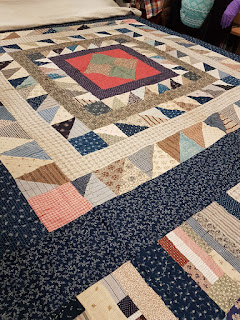At the end of October 2019, the annual seminar of the British Quilt Study Group was held in Farnborough, Surrey. The hotel was the Holiday Inn, more "up market" than some we have been to!
Our study day was at the Craft Study Center, University for the Creative Arts in Farnham. I had never been there before, and did not even know that it existed, so was interested to visit. In the Craft Study Centre, there are two display rooms with various crafts displayed.
The quilts we were shown are not the property of the Study Centre, but were brought across from the Textile collection at the University.
Quilt circa 1834-45. Aged, so darkened. Colour combination of Prussian Blue and Brown is characteristic of this period. Also seen is indigo. Wavy border is unusual.
Cushion cover - second half 19C. Lined with linen. Silk, but not salted. Fabric samples? Some ink spills seen.
Piece made by professional workshops - Pattern and texture, not warmth. Paisley motifs, vermicelli, eyelets.
Chair cover - c 1790. Complete chair cover, Dimity, chintz. Is fringe contemporary? Seems unused.
Mid 19C - Brown, Prussian blue, some crudely printed. Purples are browning. Less yellow. Pieced with both running stitch and whip stitch.
Quilt mid 19C - Pieces are roller printed and block printed - 1 green patch.
Later quilt than two previous quilts - double pinks, seconds, Creases in printing. Unfinished. Not quilted. Still glazed, raw edges. Paisley border was machined. From an antique store in Farnham, but probably Westmoreland origin.
Patchwork quilt cover, predominantly blue with geometric designs, Includes indigo discharge fabrics. Reverse is resist printed indigo over discharge and an earlier fabric than the front.
The Seminar was interesting, as always. I had brought some of my Rural Industries Bureau quilts and samples. This is Liz Nally showing a lovely bed jacket.
One of Jenny Barlow's quilts - a Sanderson Star.
The Archives held at The Craft Study Centre include the archives of Muriel Rose and The Little Shop. It was interesting to look at the receipt book - prices were high for that time and customers seemed mainly the aristocracy. There was also a complete copy of the catalogue - this proved what I has always thought, that Margaret Williams was a RIB quilter from Wales. Here is the page showing one of her characteristic quilts. One of the cushions also looks to be her work.



























